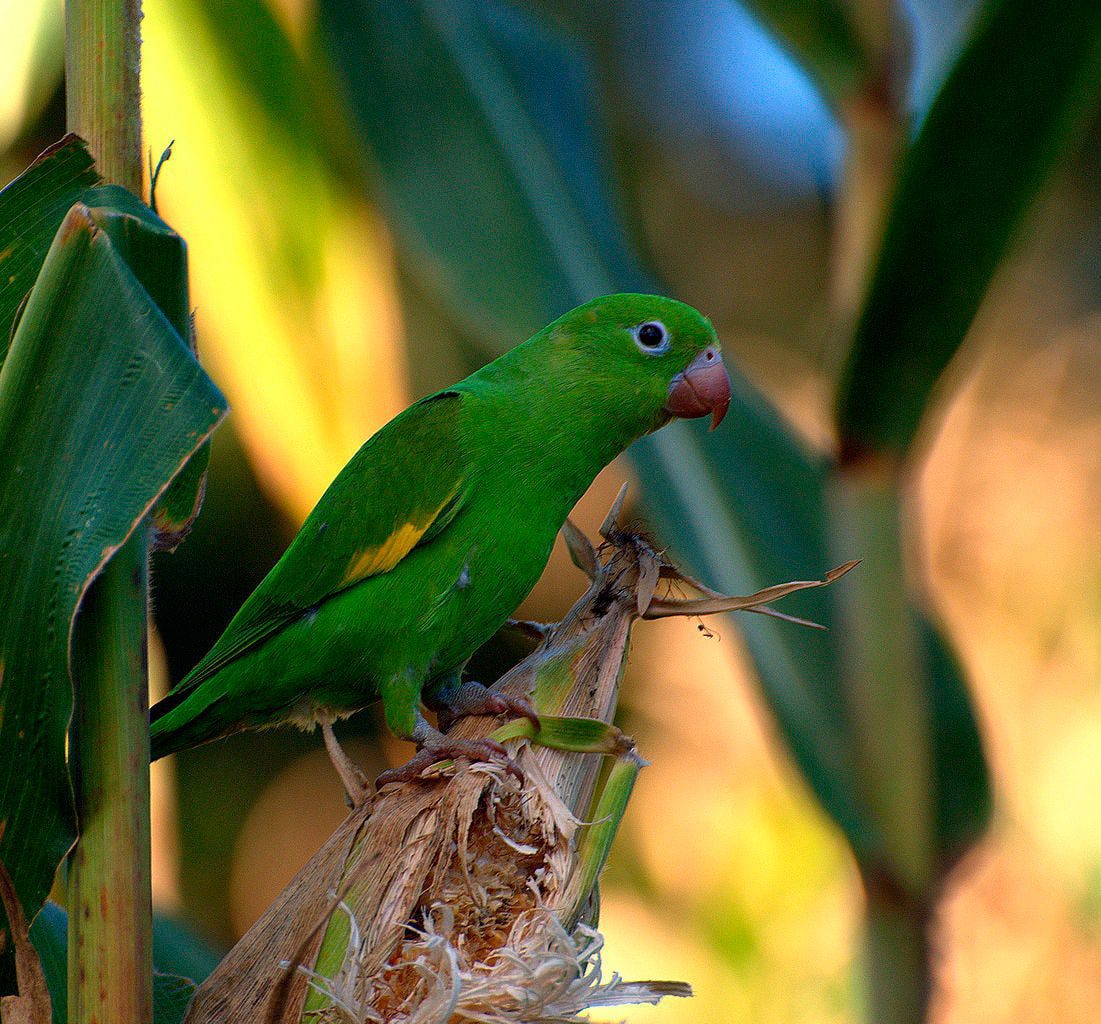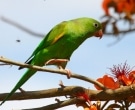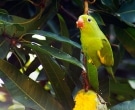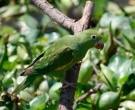Content |
|---|
Description:
20-25 cm.. length and 72 g. of weight.
The Yellow-chevroned parakeet (Brotogeris chiriri) has a plumage, in general, bright green; the underparts They are of a paler green and lower coverts are yellowish-green.
The wings They are of a slightly darker green, with the yellow border, visible when wings remain bent or when the bird is in flight. Their bill, hook-shaped, is orange-brown and legs and feet, pinkish gray. The eye rings They are creamy white and eyes dark browns.
It is intimately related to the Canary-winged Parakeet (Brotogeris versicolurus). In fact, it was considered conspécifica (owned or belonging to the same species) until 1997.
The females sexually dimorphic and are not to be sexed, either surgically or by DNA.
The immature are similar to adults but have the tail shorter and the bill It is a darker brown.
Taxonomic note:
-
Until 1997, some taxonomists considered the Canary-winged Parakeet and Yellow-chevroned parakeet belonging to the same species. Even though the Yellow-chevroned parakeet It has the same secondary covert yellow feathers that can be seen in the Canary-winged Parakeet – no white in the primary wing feathers.
- Sound of the Yellow-chevroned parakeet.
Description 2 subspecies:
-
Brotogeris chiriri behni
(Neumann, 1931) – Similar to the nominal species, except that they are slightly larger; the body green lacks the yellow dye.
-
Brotogeris chiriri chiriri
(Vieillot, 1818) – Nominal.
Habitat:
Video – "Yellow-chevroned parakeet" (Brotogeris chiriri) |
|---|
They are mainly below 1000 m, locally up 2500 meters in a variety of habitats including humid forests, seasonal and coastal, Pantanal, savannah and city parks. reported to 2500 meters in arid areas.
Usually, traveling in flocks; in such small groups as 2 to 4 birds, but they have been observed to 20. They are described as small parrots assets, entertaining to watch.
Reproduction:
Nest usually in the cavities of trees or in tree termite nests. They also form nesting tunnels in dead palm fronds..
Once a nest It has been located and correctly “prepared” the couple, It is performed the laying, between 4 and 5 eggs. after breeding, the Yellow-chevroned parakeet they form large communal huts until the next breeding season.
Food:
In their natural habitats, feed of seeds (including outbreaks), fruit as berries and figs and flowers. Also consume nectar, insects and their larvae. Often they are seen visiting barreiros (areas where there is soil rich in minerals) and the banks of the rivers to feed on the soil.
Distribution:
Size of its range (breeding/resident ): 5,670,000 km2
Distributed inside East Brazil to the East of Bolivia, Paraguay and North of Argentina, in Formosa, Chaco, Missions and North of Currents. Introduced populations in Miami, Florida and California.
Distribution 2 subspecies:
-
Brotogeris chiriri behni
(Neumann, 1931) – Center of Bolivia to the Northwest of Argentina, in Salta.
-
Brotogeris chiriri chiriri
(Vieillot, 1818) – Nominal.
Conservation:
State of conservation ⓘ |
||
|---|---|---|
 Minor Concern ⓘ
(UICN)ⓘ
Minor Concern ⓘ
(UICN)ⓘ
| ||
• Current category of the Red List of the UICN: Least concern.
• Population trend: Stable.
Rationale for the Red List category
This species has a extremely large range and, therefore, it does not approach the thresholds of vulnerability under the criteria of size range (Extension <20,000 km2 combinada con un tamaño de rango decreciente o fluctuante, extensión / calidad de hábitat o tamaño de población y un pequeño número De lugares o fragmentación severa). La demographic trend appears to be stable and, therefore, the species does not approach the thresholds Vulnerable under the criteria of population trend (> 30% decline over ten years or three generations). The population size has not been quantified, but it is not believed to be close to the thresholds for Vulnerable under the criterion of population size (<10.000 individuos maduros con un descenso continuo estimado> 10% in ten years or three generations or a population structure). For these reasons the species is evaluated as the least concern.
Justification of the population
The size of the world's population has not been quantified, but this species is described as “quite common” (Stotz et to the., 1996).
Justification of trend
They suspected that the population is stable in absence of evidence of any decline or threatens substantial.
"Yellow-chevroned parakeet" in captivity:
Today is Rare.
Since the late sixties to mid-seventies, more than 260.000 these were parakeets imported from South America for the pet trade. At that moment, the Yellow-chevroned parakeet It was the most imported parrot. They settled in California (Los Angeles, San Francisco) self-sustaining populations Yellow-chevroned parakeet released or escapes; populations also in Florida (Miami), as well as Connecticut and New York City.
The Chirirí Kitten appears to be better suited to its adopted habitat than its closely related cousin., the the Canary-winged Parakeet (Brotogeris versicolurus).
The Canary-winged Parakeet It has declined considerably since the early 80, while the Yellow-chevroned parakeet It has established itself in different habitats.
In 2002, the population of Yellow-chevroned parakeet in the area of Los Angeles, California It was estimated at 400 individuals. In the Florida, They have prospered more than any other place in the United States – there have been huge flocks, several hundred of them. The species is also quite established in the city center Rio de Janeiro, Brazil, which he was also introduced.
Alternative names:
– Yellow-chevroned Parakeet, Chiriri Parakeet, Yellow chevroned Parakeet (English).
– Toui à ailes jaunes, Conure à ailes jaunes, Perruche ou, Toui à miroir jaune, Toui chiriri (French).
– Gelbflügelsittich, Kanarienflügelsittich (German).
– periquito-de-encontro-amarelo, periquio-de-encontro-amarelo, periquito-de-asa-amarela, tuí-chiriri (Portuguese).
– Catita chiriri, Catita Chirirí, Catita chíriri (español).
– Catita chirirí (Argentina).
– Catita chiriri, Catita chíriri (Paraguay).
– Tu’î Chyryry (Guarani).
scientific classification:
– Order: Psittaciformes
– Family: Psittacidae
– Genus: Brotogeris
– Scientific name: Brotogeris chiriri
– Citation: (Vieillot, 1818)
– Protonimo: Psittacus chiriri
Images Catita Chiriri:
Sources:
– Avibase
– Parrots of the World – Forshaw Joseph M
– Parrots A Guide to the Parrots of the World – Tony Juniper & Mike Parr
– Birdlife
– Photos:
(1) – A Yellow-chevroned Parakeet in Sarutaiá, Sao Paulo, Brazil By Dario Sanches [CC BY-SA 2.0], via Wikimedia Commons
(2) – A pet Yellow-chevroned Parakeet By Wagner Machado Carlos Lemes from Goiânia, Brazil [CC BY 2.0], via Wikimedia Commons
(3) – A Yellow-chevroned Parakeet perching in a tree By Paulo Barradas (Brotogeris chiririUploaded by Sno whom You nradio) [CC BY 2.0], via Wikimedia Commons
(4) – A Yellow-chevroned Parakeet in Goiânia, Goiás, Brazil By Delcio Gonçalves from Goiânia, Brazil (A corn diferenteUploaded by Snowmanradio) [CC BY 2.0], via Wikimedia Commons
(5) – Parakeet yellow meeting. Photo taken in the hinterlands of the Sucuriú River By Deusdedith de Souza Alves Filho DehAlves (Own work) [CC BY-SA 4.0], via Wikimedia Commons
(6) – Yellow-chevroned Parakeet (Brotogeris chiriri)(Left) and Peach-fronted Parakeet (Aratinga aurea)(Right) on Combretum flowers By Bernard DUPONT from FRANCE [CC BY-SA 2.0], via Wikimedia Commons
(7) – A Yellow-chevroned Parakeet in Brazil By Alastair Rae (Flickr: Yellow-chevroned Parakeet) [CC BY-SA 2.0], via Wikimedia Commons
(8) – A Yellow-chevroned Parakeet in Bonito, Mato Grosso do Sul, Brazil. It is perching on the stem of a mango, which it has been eating By Alexandre Pereira [CC BY-SA 2.0], via Wikimedia Commons
(9) – A Yellow-chevroned Parakeet on Erythrina velutina By Derek Keats from Johannesburg, South Africa (… on Erythrina velutina) [CC BY 2.0], via Wikimedia Commons
– Sounds: Fernando Igor de Godoy (Xeno-canto)









